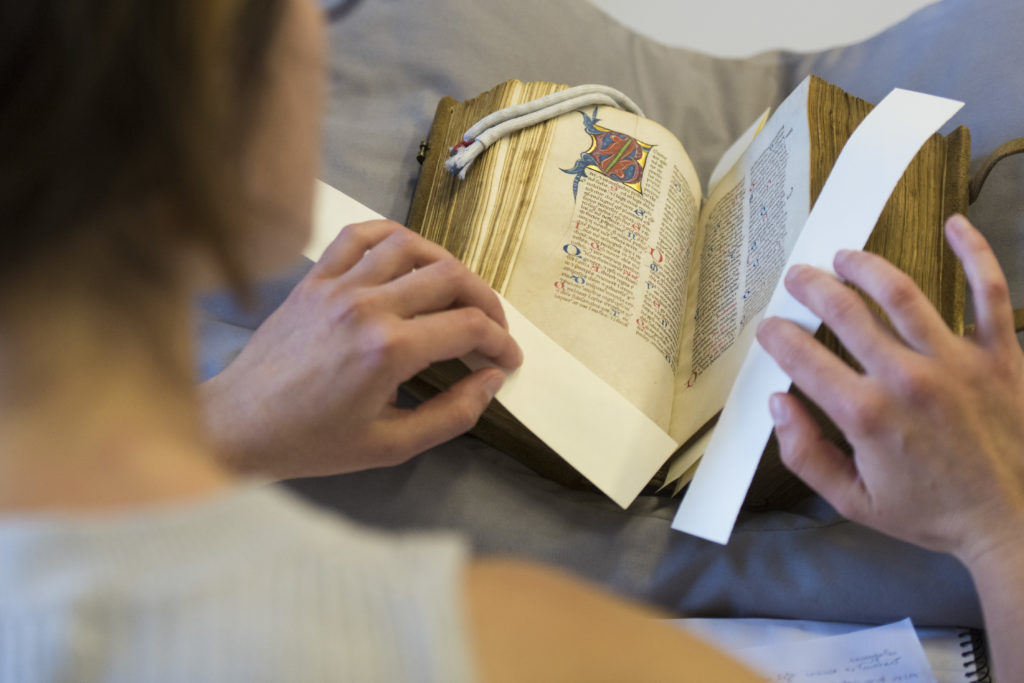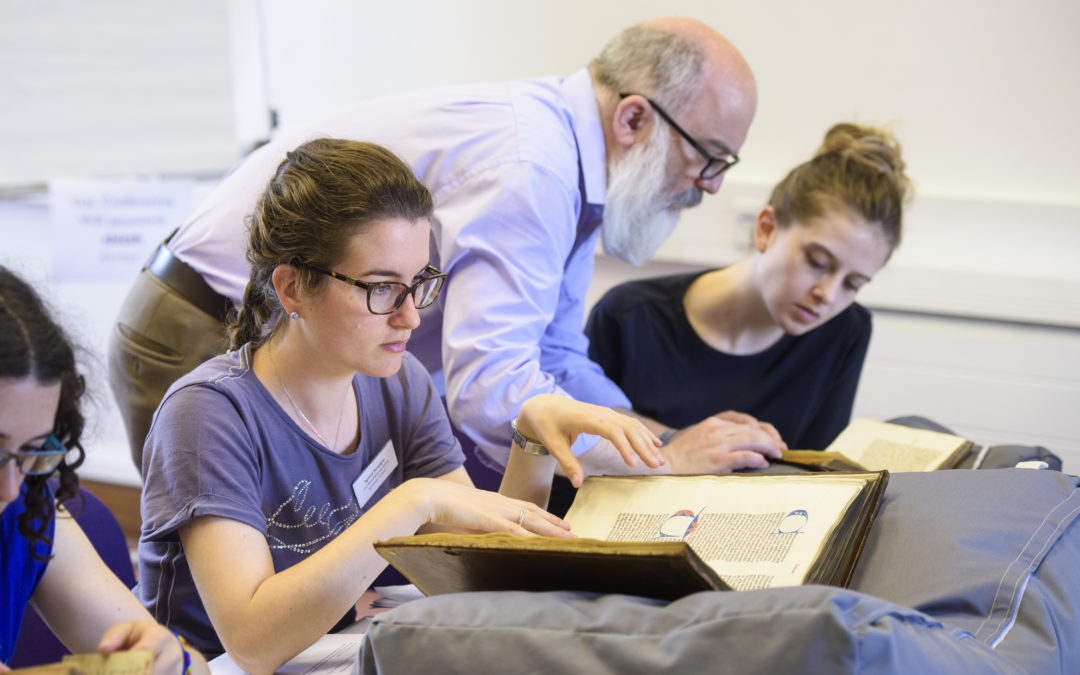Our London International Palaeography Summer School (LIPSS) tutors offer specialized training in a wide variety of subjects, but they share a love of manuscripts. Here five of the team tell us about why they are passionate about palaeography and how they got into studying it.
Dr Debby Banham
x þusend punda, I read. ‘I can read that!’, I thought. Living in rural Lincolnshire, I had joined an evening class on The Anglo-Saxons and Vikings, and now we were on a class outing to an exhibition about the Vikings in York. The caption to a manuscript of the Anglo-Saxon Chronicle explained that it listed the amounts of ‘Danegeld’ paid out during the reign of Æthelred ‘the Unready’, and, leaning over the case, I could see just how much one of the payments was. Once you knew that the Old English ‘thorn’ character stands for a ‘th’ sound, it was pretty clear. I’d always know that medieval manuscripts could be beautiful objects, but the idea of actually reading them came as a revelation to me.
Being able to study manuscripts at undergraduate level was one of the main reasons I applied for Anglo-Saxon, Norse and Celtic at Cambridge. In those days, undergrads could still work with the manuscripts in the University Library. I later found out that it was the enthusiasm of my cohort of students that caused this to change – the sight of five of us crowding round the Moore Bede, the earliest surviving manuscript of the Ecclesiastical History, was too much for the librarian’s nerves – but we were lucky enough to sit and describe a manuscript over the Christmas holidays as part of our course. Nowadays, the quality of reproductions is enormously improved on the splotchy photocopies we worked with, and they are freely available in their thousands, so I don’t feel quite so bad about depriving subsequent students of the opportunity to work with the real thing. And we didn’t do it on purpose, honest! We were just being diligent, and it was a real thrill to see such an important manuscript in the flesh. And it still is.
Debby teaches an Introduction to Palaeography of Early Medieval England.
Dr Claudia Wedepohl
In my capacity as both scholar and curator I’m actively researching the Warburg Institute’s history, in particular the genesis of Aby Warburg’s thought, ideas and concepts. Reading through his diaries and personal correspondences has always been the most fascinating aspect of this research. The information — usually much fresher in its spontaneous nature — gives such a unique insight into the mind of a much-talked-about thinker whose work is fairly difficult to penetrate. You really get to know the greatest historical figures, almost intimately, by deciphering their private papers.
Claudia teaches German Palaeography.
Patricia Lovett
I have to admit that my first love was geography and after my initial degree I was due to take up an MA in Cartography, but found that it was more statistical than I could manage. I went into business for a while and then into teaching in large London comprehensive schools, but all the while I hand-drew maps for publications. My frustration was not being able to put the names etc on the maps and so I went off to art college to learn how to letter. The course was Calligraphy – I wanted to do that, Illumination – I didn’t know what that was (!), and Heraldry – which I thought was so archaic! However, on day one I was entranced by the gold, colour and history. My training covered the skills and techniques of the mediaeval scribe and illuminator and I absolutely loved it. This took me into manuscripts and the love affair began …!
Patricia teaches How Medieval Manuscripts Were Made and an Illumination Masterclass.

Dr Colleen Curran
I’ve been fascinated by textual transmission for a long time. In high school Latin classes, I would ask how the text of Cicero that we were translating came to exist in its edited state. Throughout undergrad, I continued following these questions and I wrote a term paper on the Libri Carolini (Vatican City, Biblioteca Apostolica Vaticana, MS Vat. lat. 7207). I became caught up in wondering how many scribes wrote the manuscript, what the differing quality of their Caroline minuscule might imply, why certain sections were crossed out, and what was the lasting impact of this particular text. But holding a manuscript in my own hands for the first time in October 2011 as a graduate student is really what made me pursue palaeography. Being able to hold an artefact is such an immediate and direct connection with the past. The questions that I am able to pursue because of palaeographical investigation – who wrote the text, and why was it copied into a manuscript? who wrote this manuscript? who later read and annotated this manuscript, and why? where was the manuscript made and why? – have led to unique research experiences. From holding a book that St Dunstan himself might have held and used to working in the very monastery in which a manuscript might have been written, palaeographical research allows a historian to go back in time, and it’s why I fell in love with palaeography.
Colleen teaches Insular Caroline Scripts
Dr Katherine Hindley
I fell in love with manuscript research because of a volcano. In 2010, my palaeography class travelled to Italy to see the Old English poetic codex known as the Vercelli Book. After a pleasant week spent eating pizza, drinking wine, and working in the archives, the volcano Eyjafjallajökull erupted, flights were grounded, and we found ourselves trapped in Vercelli for an uncertain amount of time. And so (like good palaeography students) we went back to the archive, where the librarian let us into the book stack. Inspired by a tiny, intricate Book of Hours we had seen in a museum a few days earlier, we decided to find the smallest manuscript in the stacks. It turned out to be uncatalogued and, in part, in English. Until we could fly home again, this manuscript became our project: we identified its unpublished texts, tried and failed to decipher its ownership inscription, and photographed the minute instructions to its illuminators under ultraviolet light. As we worked, and as each person identified their own specific area of interest, it became clear just how many stories can spiral from a single book. The experience showed me the difference between liking manuscripts and liking manuscript research, and I’ve been doing manuscript research ever since!
Katherine is the Director of LIPSS.
You can find out more about our LIPSS tutors here. For more Palaeography resources, including more blog posts, recordings and a transcription challenge, take a look at our new Palaeography Online page.

